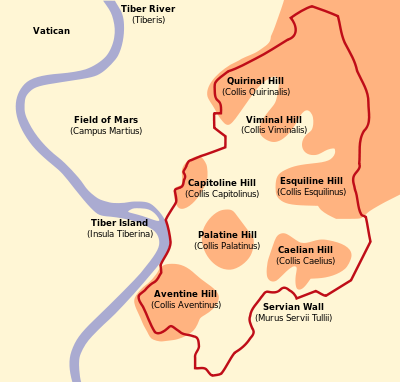Seven hills of Rome
This article needs additional citations for verification. (November 2013) |

The Seven Hills of Rome (Template:Lang-it [ˈsɛtte ˈkɔlli di ˈroːma], Template:Lang-la) east of the river Tiber form the geographical heart of Rome, within the walls of the city.
The seven hills are:[1]
- Aventine Hill (Latin, Aventinus; Italian, Aventino)
- Caelian Hill (Cælius, Celio)
- Capitoline Hill (Capitolinus, Campidoglio)
- Esquiline Hill (Esquilinus, Esquilino)
- Palatine Hill (Palatinus, Palatino)
- Quirinal Hill (Quirinalis, Quirinale)
- Viminal Hill (Viminalis, Viminale)
The Vatican Hill (Latin Collis Vaticanus) lying northwest of the Tiber, the Pincian Hill (Latin Mons Pincius), lying to the north, and the Janiculum Hill (Latin Ianiculum), lying to the west, are not counted among the traditional Seven Hills.
History
Tradition holds that Romulus founded the original city on the Palatine Hill and that the seven hills were first occupied by small settlements that were not grouped nor recognized as a city called Rome. The seven hills' denizens began to participate in a series of religious games, which began to bond the groups. The city of Rome, thus, came into being as these separate settlements acted as a group, draining the marshy valleys between them and turning them into markets (fora in Latin). Later, in the early 4th century BC, the Servian Walls were constructed to protect the seven hills.
Of the seven hills of current Rome, five (the Aventine, Caelian, Esquiline, Quirinal, and Viminal Hills) are populated with monuments, buildings, and parks. The Capitoline Hill now hosts Rome's city hall, and the Palatine Hill belongs to the main archaeological area.
Constantinople is claimed to have been built on the seven hills, following the example of Rome. See Seven hills of Istanbul.
References
- ^ Heiken, Grant; Funiciello, Renato; de Rita, Donatella (Oct 24, 2013). "Chapter 11: Field Trips in and Around Rome". The Seven Hills of Rome: A Geological Tour of the Eternal City. Princeton University Press. p. 174. ISBN 9780691130385.
See also
Other Roman hills:
- Cispian Hill (Cispio)
- Monte Mario
- Oppian Hill (Oppio)
- Velian Hill (Velia)
- Monte Testaccio, an artificial hill composed primarily of broken amphorae
General:
